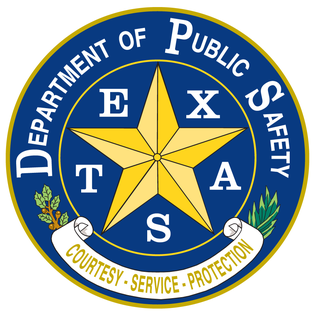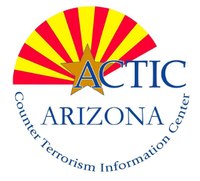
The United States Department of Homeland Security (DHS) is a cabinet department of the U.S. federal government with responsibilities in public security, roughly comparable to the interior or home ministries of other countries. Its stated missions involve anti-terrorism, border security, immigration and customs, cyber security, and disaster prevention and management. It was created in response to the September 11 attacks and is the youngest U.S. cabinet department.
A State Bureau of Investigation (SBI) is a state-level detective agency in the United States. They are plainclothes agencies which usually investigate both criminal and civil cases involving the state and/or multiple jurisdictions. They also typically provide technical support to local agencies in the form of laboratory and/or record services.

The Texas Department of Public Safety (DPS) is a department of the government of the state of Texas. DPS is responsible for statewide law enforcement and vehicle regulation. The Public Safety Commission oversees DPS. However, under state law, the Governor of Texas may assume personal command of the department during a public disaster, riot, insurrection, or formation of a dangerous resistance to enforcement of law, or to perform his constitutional duty to enforce law. The commission's five members are appointed by the governor and confirmed by the Texas Senate, to serve without pay for staggered, six-year terms. The commission formulates plans and policies for enforcing criminal, traffic and safety laws, for preventing and detecting crime, for apprehending law violators and for educating citizens about laws and public safety.
In the United States, a department of Public Safety is a state or local government agency which often has a broad portfolio of responsibilities, which may include some or all of the following:
Campus police or university police in the United States, Canada are often sworn police officers employed by a college or university to protect that private property of the campus and surrounding areas and the people who live, work, and visit it.
A Department of Corrections is a governmental agency responsible for overseeing the incarceration of people convicted of crimes within a particular jurisdiction. Traditionally the Department of Corrections is responsible for handling all aspects of State executions. Entities serving that purpose include:
Capitol police in the United States are agencies charged with the provision of security police services for various state agencies, but especially State Legislatures. Capitol police may function as part of the state police or may be an independent agency. There is also a federal capitol police agency.

The Hawaii Department of Public Safety is a department within the executive branch of the government of the U.S. state of Hawaii. It is headquartered in Room 400 in the 919 Ala Moana Boulevard building in Honolulu, Hawaii. The Department of Public Safety is made up of three divisions.
A Sector is a shore-based operational unit of the United States Coast Guard. Each Sector is responsible for the execution of all Coast Guard missions within its Area of Responsibility (AOR), with operational support from Coast Guard Cutters and Air Stations. Subordinate commands within a Sector typically include Stations and Aids-to-Navigation (ATON) Teams. Some Sector commands also have subordinate units such as Sector Field Offices and Marine Safety Units that are responsible for mission execution in parts of the Sector's AOR. There are 37 sectors within the Coast Guard.

The Border and Maritime Security Division (BMD) is a division of the Science and Technology Directorate of the United States Department of Homeland Security. Within the Homeland Security Advanced Research Projects Agency, BMD develops tools and technologies that improve the security of the United States's land borders and waterways.
The government of Arizona is the governmental structure of the state of Arizona as established by the Arizona Constitution. The executive is composed of the Governor, several other statewide elected officials, and the Governor's cabinet. The Arizona Legislature consists of the House of Representatives and Senate. The judiciary is composed of the Arizona Supreme Court and lower courts. There is also local government, consisting of counties, municipalities and special districts.

In the United States, state police are a police body unique to each U.S. state, having statewide authority to conduct law enforcement activities and criminal investigations. In general, they perform functions outside the jurisdiction of the county sheriff, such as enforcing traffic laws on state highways and interstate expressways, overseeing the security of the state capitol complex, protecting the governor, training new officers for local police forces too small to operate an academy and providing technological and scientific services. They support local police and help to coordinate multi-jurisdictional task force activity in serious or complicated cases in those states that grant full police powers statewide.
The Center for Homeland Defense and Security at the Naval Postgraduate School (NPS) in Monterey, California is a school focusing on homeland security education.
A suspicious activity report is a report of suspicious activity that may either be a terrorist act, a criminal act, or a non-criminal act considered a precursor to either a terrorist act or criminal act. A SAR may be filed by law enforcement, public safety personnel, owners of critical infrastructure or the general public. The report is the incident level event reported under the National SAR Initiative, a joint project of the United States Department of Justice and the United States Department of Homeland Security. It is run by the SAR Program Office in the Department of Justice. SARs are completed at the local, state or federal law enforcement level and shared with fusion centers who make the information available to local law enforcement agencies, United States Department of Justice and the United States Department of Homeland Security the FBI, the Department of Defense and private partners. Fusion centers have been criticized by a U.S. Senate Committee which found that the fusion centers often produced "irrelevant, useless or inappropriate intelligence reporting"

The Alabama Law Enforcement Agency, abbreviated as "ALEA", is a law enforcement agency serving the U.S. state of Alabama. It exists within the Executive Branch of State Government to coordinate public safety in Alabama. It was formed on 1 January 2015 by the merger of 12 state law enforcement agencies. The Secretary, its chief executive, is appointed by and serves at the pleasure of the Governor of Alabama. ALEA is divided into two functional divisions, the Department of Public Safety and the State Bureau of Investigations. The Secretary of ALEA is responsible for appointing a Director of both divisions, after consultation with the Governor.







